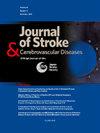Sex differences on cerebrovascular complications in hospitalized COVID-19 patients: a meta-analysis
IF 1.8
4区 医学
Q3 NEUROSCIENCES
Journal of Stroke & Cerebrovascular Diseases
Pub Date : 2025-06-13
DOI:10.1016/j.jstrokecerebrovasdis.2025.108377
引用次数: 0
Abstract
Background
Although pre-pandemic data suggest a higher stroke incidence in females, recent evidence suggests COVID-19-related strokes disproportionately affect males. Prior studies often analyzed stroke as a composite outcome without stratifying by biologically distinct subtypes. This systematic review and meta-analysis evaluated sex differences in the risk of ischemic and hemorrhagic stroke among hospitalized patients with COVID-19.
Methods
We searched MEDLINE and six additional databases from inception to December 2024. We included observational studies enrolling adults (≥18 years) with active COVID-19 infection, hospitalized, and reporting sex-stratified stroke outcomes. Pooled risk ratios (RRs) for each stroke subtype were calculated using random-effects models. We defined RR as the ratio of the cumulative incidence of type of stroke in males over the cumulative incidence of the same type of stroke in females.
Results
Seventeen studies comprising 135,481 hospitalized COVID-19 patients (mean age 63.3 years; 48.7% male) met inclusion criteria. Stroke occurred in 1,509 patients (1.1%), with ischemic stroke accounting for 53.9% of cases, unspecified stroke for 30.1%, and hemorrhagic stroke for 16.1%. Males accounted for a greater proportion of stroke cases across all subtypes: 63.1% of ischemic, 69.0% of hemorrhagic, and 59.0% of unspecified strokes. The estimated prevalence of ischemic stroke was 17% in males (95% CI, 15%–20%) versus 9% in females (95% CI, 7%–11%), and hemorrhagic stroke occurred in 4% of males (95% CI, 2%–6%) versus 1% of females (95% CI, 0%–2%). Unspecified stroke occurred in 2% of both sexes (95% CI, 0%–3%). Pooled risk estimates showed that males had a significantly higher risk of any stroke (RR = 1.25; 95% CI,1.05-1.50), driven by an elevated risk of hemorrhagic stroke (RR = 1.64; 95% CI, 1.06-2.54). The increased risk of ischemic stroke in males did not reach statistical significance (RR = 1.18; 95% CI, 0.97–1.44).
Conclusions
This is the first meta-analysis to stratify stroke risk by sex and stroke subtype in hospitalized COVID-19 patients. Males were at significantly higher risk for hemorrhagic stroke, suggesting possible sex-specific vulnerability that warrants further studies.
COVID-19住院患者脑血管并发症的性别差异:荟萃分析
尽管大流行前的数据表明,女性中风发病率较高,但最近的证据表明,与covid -19相关的中风对男性的影响尤为严重。先前的研究通常将中风作为一种综合结果进行分析,而没有按生物学上不同的亚型进行分层。本系统综述和荟萃分析评估了COVID-19住院患者缺血性和出血性卒中风险的性别差异。方法检索MEDLINE数据库及其他6个数据库,检索时间自成立至2024年12月。我们纳入了观察性研究,纳入了活动性COVID-19感染、住院的成人(≥18岁),并报告了按性别分层的卒中结局。采用随机效应模型计算各卒中亚型的合并风险比(rr)。我们将RR定义为男性卒中类型累积发病率与女性相同卒中类型累积发病率之比。结果17项研究纳入135,481例住院COVID-19患者(平均年龄63.3岁;48.7%男性)符合纳入标准。1509例(1.1%)发生脑卒中,其中缺血性脑卒中占53.9%,不明原因脑卒中占30.1%,出血性脑卒中占16.1%。在所有亚型的中风病例中,男性占更大的比例:缺血性中风占63.1%,出血性中风占69.0%,不明类型中风占59.0%。缺血性卒中的估计患病率男性为17% (95% CI, 15%-20%),女性为9% (95% CI, 7%-11%),出血性卒中发生率男性为4% (95% CI, 2%-6%),女性为1% (95% CI, 0%-2%)。未指明的卒中发生率在两性中均为2% (95% CI, 0%-3%)。综合风险估计显示,男性发生任何中风的风险都明显更高(RR = 1.25;95% CI,1.05-1.50),由出血性卒中风险升高驱动(RR = 1.64;95% ci, 1.06-2.54)。男性缺血性卒中风险增加无统计学意义(RR = 1.18;95% ci, 0.97-1.44)。这是首个按性别和脑卒中亚型对住院COVID-19患者脑卒中风险进行分层的meta分析。男性出血性中风的风险明显更高,这表明可能存在性别特异性的易感性,值得进一步研究。
本文章由计算机程序翻译,如有差异,请以英文原文为准。
求助全文
约1分钟内获得全文
求助全文
来源期刊

Journal of Stroke & Cerebrovascular Diseases
Medicine-Surgery
CiteScore
5.00
自引率
4.00%
发文量
583
审稿时长
62 days
期刊介绍:
The Journal of Stroke & Cerebrovascular Diseases publishes original papers on basic and clinical science related to the fields of stroke and cerebrovascular diseases. The Journal also features review articles, controversies, methods and technical notes, selected case reports and other original articles of special nature. Its editorial mission is to focus on prevention and repair of cerebrovascular disease. Clinical papers emphasize medical and surgical aspects of stroke, clinical trials and design, epidemiology, stroke care delivery systems and outcomes, imaging sciences and rehabilitation of stroke. The Journal will be of special interest to specialists involved in caring for patients with cerebrovascular disease, including neurologists, neurosurgeons and cardiologists.
 求助内容:
求助内容: 应助结果提醒方式:
应助结果提醒方式:


